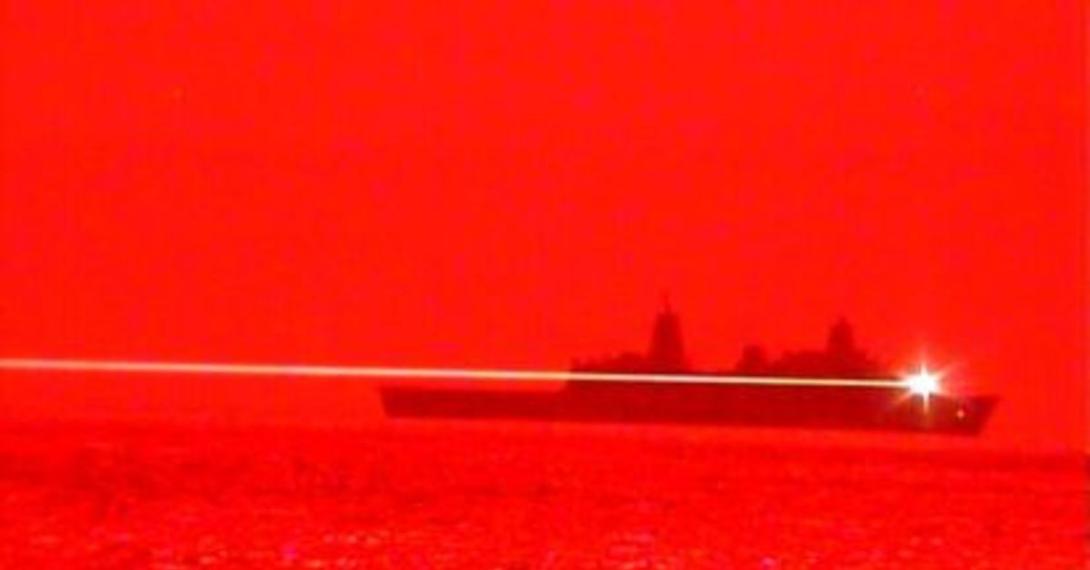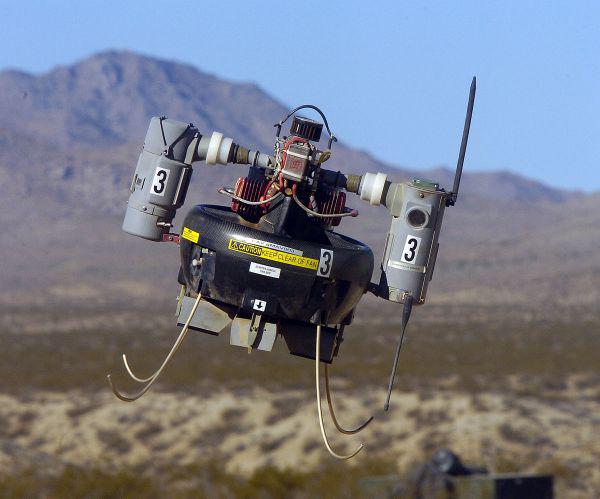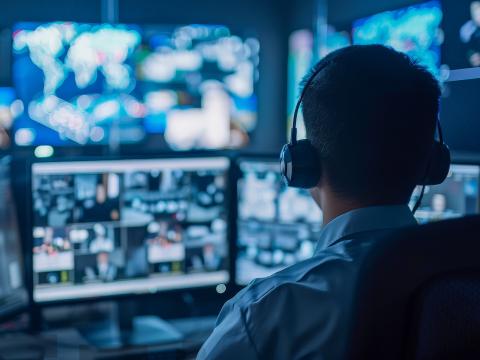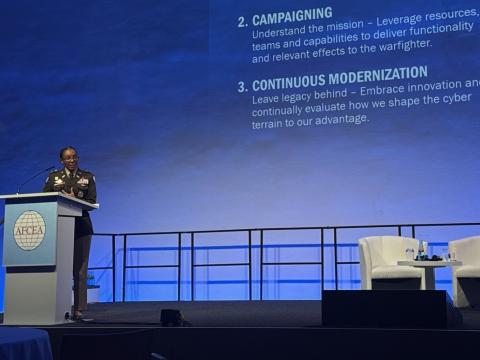INDOPACOM Aims to Combine Hypersonics, Lasers and AI
The potential proliferation of hypersonic weapons highlights the need to advance a wide range of other technologies, including artificial intelligence, machine learning, autonomy, laser weapons and fully networked command, control and communications systems, says George Kailiwai III, director, requirements and resources (J-8) for U.S. Indo-Pacific Command.
Russia and China in recent years have made significant advances in hypersonic weapons capable of flying thousands of miles at five times the speed of sound. Those advances have left the United States scrambling to dust off, further mature and rapidly field hypersonic technologies developed years ago and never used. Such long-range capabilities call for the fielding of an array of other cutting-edge technologies.
“When we look at these advanced capabilities, I’m not looking at them in isolation. We can use the technology in one area, like in artificial intelligence and machine learning, and apply that to things like fully networked command and control and communication systems and things like hypersonic weapons,” says Kailiwai, who has served as the command’s J-8 since 2007, which makes him the longest-standing current J-8 within a combatant command.
Kailiwai foresees the innovative systems being packaged together and used in layers. “On the offensive side, we can create those long-range fire effects through things like cyber warfare. We can do that very rapidly. And we can use hypersonic weapons that fly five times faster than the speed of sound and hit the target in minutes, and then we can also use traditional weapons like Tomahawks that are subsonic. So, it’s like a layering of capabilities that we’re able to put into the targeteers’ hands on the offensive side.”
The same is true for defensive purposes, he adds. “On the defense side, likewise, we think in terms of a layered defense—directed energy is something that comes to mind. And then you also have to have, for both offense and defense, a networked command and control and communications system.”
He notes that it is not necessarily the mind-boggling capabilities of modern weapons that matter most. “Unfortunately, a lot of folks when they think we’re either behind or we’re ahead [of adversaries], they tend to think in terms of simplistic measures of performance like numbers or ranges. It’s not just the technologies themselves but the applications of these capabilities that matter the most.”
The United States has made progress with its hypersonic weapons capabilities, according to Kailiwai. “I’m very pleased with where the department is going, with the emphasis that it’s placing on hypersonic weapons. The amount of resources that the department has started to put in hypersonics is a tremendous increase,” he says, citing the greater number of flight tests. “In the past, we were looking at doing maybe one flight test per year or one flight test over a couple of years, now we’re looking at doing several dozen flight tests, and that’s just over the next year.”
As the J-8, Kailiwai facilitates the development of the command’s requirements, translates those requirements into material and nonmaterial solutions through advocacy, science and technology and innovation and experimentation. He also assists the global campaign plan assessment process and manages the $200 million annual budget for the command’s headquarters.
His team also leads experimentation for the command. He stresses the importance of exercises and experiments to help develop and integrate emerging technologies. “We’re going to do that as best as we possibly can through a robust joint experimentation and exercise program so that we can start building our confidence in how we bring together all of these systems of systems in a warfighting or operational environment.”
For example, during Valiant Shield 2020, the command assessed a variety of capabilities, mostly focused on command and control. Because of the pandemic, the command narrowed the number of experiments from 20 or more down to eight. Officials also took a new approach combining all eight experiments rather than conducting individual, disparate experiments.
Valiant Shield included a couple of prototypical command and control systems, as well as an All-Domain Operations Center concept and Multi-Domain Battle Management Teams, or MBMTs. “These MBMTs are composed of targeteers essentially across all the services who actually operate as a single team. We were able to make a lot of multidomain targeting decisions very rapidly in that type of a construct,” Kailiwai reports. “We’re also looking at long-range kill webs, as opposed to kill chains. These will be comprised of new space-based and strategic sensors.”
He cites another capability known as Diversified, Terrestrial, Wireless, Airborne and Resilient Space-Based Communications, as well as emerging weapons systems, hypersonic weapons being one of the bigger ones.
The systems and concepts evaluated during Valiant Shield mostly shared one common thread. “It’s about command and control. For multidomain long-range fires, for instance, when you think about command and control, you also have to take into consideration the [intelligence, surveillance and reconnaissance] that’s needed for the targeting piece. You also have to think in terms of long-range communications and long-range data links if needed,” he adds. “We can’t ignore the enablers for these long-range fires. We have to have effective battle management command and control.”
The lessons learned from Valiant Shield will be applied to another experiment being held this year, likely in the spring or early summer, known as Northern Edge 2021. “This year, we’ll be looking at multidomain, long-range fires … joint, all-domain command and control, and we’re also looking at contested logistics,” the J-8 reveals. “A lot of those experiments will be focused on the Advanced Battle Management System, or ABMS.”
The exercises and experiments also help officials to iron out issues regarding authorities. “As you would imagine, the authorities can take some time, and often, that’s time we don’t have, so we have to figure out in exercises how to get those authorities in a rapid fashion to still prosecute the targets that we’re going to prosecute,” Kailiwai states.
The Indo-Pacific Command (INDOPACOM) team
already can boast of several successful experiments. For example, nearly a year ago, the Office of Naval Research installed a Laser Weapon System Demonstrator on the USS Portland for an at-sea demonstration during which the laser shot down a drone flying nearby. It was the first system-level implementation of a high-energy, solid-state laser.
And in 2011, when an earthquake and tsunami resulted in a nuclear plant accident in Fukushima, Japan, the team realized an immediate need to build long-range sensors for chemical, biological, radiological and nuclear agents and explosives. “My team went out. They experimented with a drone that would provide near real-time, geo-tagged data on a contamination site without having to put that person at risk. That capabilities persists to this day.”
The drone was a Honeywell RQ-16 T-Hawk, which Kailiwai describes as looking a bit like a miniature flying R2-D2 of Star Wars fame. “Some of my teammates had worked figuring out how to get some radiological equipment on that.” Remote sensing of such threats remains an interest for the command.
Modifying the Joint Direct Attack Munition is another success story. “We slapped a tail on it as well as some wings and changed the nose section, and we were able to modify it as an anti-ship mine,” notes Kailiwai, who describes himself as an electrical engineer by education, a flight engineer by profession.
Kailiwai’s priorities fall in line with those of his commander, Adm. Phil Davidson, USN. “My top priorities include the Homeland Defense System on Guam. That is Adm. Davidson’s top unfunded priority, and we continue to work that on a daily basis,” he says.
Another of the commander’s highest priorities is known as Pacific Multi-Domain Training and Experimentation and Capability, or PMTEC, which is his vision to integrate the test and training ranges that exist on the West Coast of the United States and in Alaska and Hawaii with the ranges in the Western Pacific. “The goal of PMTEC is to be able to emulate that warfighting environment, to be able to scale it in terms of geography so that we don’t all have to be collocated. And then also incorporate the higher echelon commands,” Kailiwai explains.
In addition to his Pacific Deterrence Initiative, a plan for countering China’s influence in the region, Adm. Davidson also has outlined a vision of a free and open Indo-Pacific. “It’s a shared vision with our allies and partners. Some of the features … are things like sovereignty for states, freedom of the seas and skies and adherence to international rules, norms and behaviors. As the J-8, it’s my job to support that vision by resourcing that vision,” Kailiwai offers.
Indeed, resourcing the commander’s requirements is one of Kailiwai’s top priorities—and one of his top challenges as well. As a combatant command, INDOPACOM has no acquisition authority and relies largely on the Defense Department and military services for resources. “My primary challenge is resourcing my commander’s requirements. I’ve got to do that. That is my bread and butter. That is what I do as a living,” Kailiwai declares.






Comments